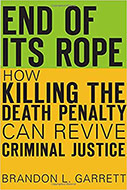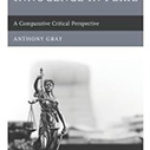End Of Its Rope: How Killing The Death Penalty Can Revive Criminal Justice

Author: Brandon L. Garrett
Publisher: Cambridge, MA: Harvard University Press, 2017. 331p.
Reviewer: Carol S. Steiker | July 2018
Will we ever abolish the American death penalty? Should we? In his carefully researched and engagingly written book, Brandon Garrett argues that we will and we must. He describes in detail the increasing fragility of the practice of capital punishment in the United States and extrapolates to its abolition “not in a matter of generations, but in a matter of years” (p. 1). Moreover, Garrett argues that the end of the death penalty may support, even catalyze, the movement to address the pathologies of the broader American criminal justice system. He offers “a road map from the demise of the death penalty to the many reforms that are so desperately needed” (p. 2).
Garrett’s book reflects the welcome empirical virtues on display in his previous work: he is willing to get his hands dirty and dig deep into data to try to understand at a granular level how and why things operate on the ground. In this case, the focus of Garrett’s attention is the stunning decline of the American death penalty over the past almost two decades. Starting in 2000, the death penalty has been in free fall, whether one counts by death sentences, which are down about ninety percent from their 1996 high, or by executions, which are down about eighty percent from their 1999 high, or by the number of states that authorize the death penalty, which has declined from thirty-eight to thirty-one in that period. This precipitous fall followed an equally precipitous rise after the Supreme Court’s temporary abolition and reinstatement of the death penalty in 1972 and 1976 respectively. After a decade from 1967 to 1977 without any executions at all, death sentences and executions soared in the 1980s and 1990s, reaching highs not seen since the early 1950s, peaking at over 300 new death sentences/year and nearly 100 executions/year in the 1990s.
What explains the death penalty’s extraordinary fall after its rapid rise? Garrett collects the data and explores the possible influence of many likely suspects, such as the innocence revolution, the decline in crime (especially homicide) rates, the rise of life-without-parole (LWOP) sentences, and the improvement of defense lawyering in capital cases. In what follows, I will evaluate both Garrett’s empirical claims about the causes of what he calls “The Great American Death Penalty Decline” (p.79) and some of his broader claims about the likelihood and likely consequences of abolition.
Three of Garrett’s claims are completely convincing. First, one of the most compelling of his empirical findings is the power of improved defense lawyering as measured by the availability of state-wide capital defense resources to support of the kind of “team” defense that is most often successful. The empirical work that Garrett undertook with law student Ankur Desai and research librarian Alexander Jakubows shows a strong correlation between such support and the decline of the death penalty. In contrast, states that rely on locally appointed lawyers, without centralized standards and resources, are less likely to see such strong declines. The American Bar Association has long advocated, in its standards for capital defense lawyers, the kind of structures and resources studied by Garrett, and experienced capital defense lawyers have strongly endorsed the importance of such support to the provision of adequate representation. But Garrett’s is the first empirical evidence to establish a connection between improved capital defense lawyering and declines in death sentencing and executions. This finding is important, even though his study confirms received wisdom, because it is often the case that “what everyone knows” turns out to be false.
Second, Garrett’s empirical work surfaces a little-known change in the locus of death penalty activity. In the death penalty’s recent heyday in the 1980s and 1990s, rural counties were much more likely to produce death sentences than urban ones. To give but one dramatic example, in Georgia in the 1990’s, the death sentencing rate ranged from four death verdicts per thousand homicides in Fulton County (Atlanta) to thirty-three death verdicts per thousand homicides in rural Muscogee County—a difference of more than 700 percent. Today, however, Garrett demonstrates that rural counties are much less likely than urban ones to return death sentences. He hypothesizes, convincingly, that the vastly increased cost of capital trials (largely the by-product of constitutional regulation of the death penalty by federal courts) has made the death penalty the exclusive province of wealthy counties. Capital punishment has become not the quicker and cheaper punishment that it was in the past, but rather a costly “luxury” that poorer jurisdictions can no longer afford.
Finally, Garrett depressingly documents in a new way the continuing role of race in the administration of the American death penalty. In our own recent book on capital punishment, Courting Death: The Supreme Court and Capital Punishment (2016), my co-author Jordan Steiker and I documented at length the long, sordid history of entwinement between race discrimination and the American death penalty. Many other empirical researchers have attempted to isolate the influence of race as a factor in the determinations of capital juries. Garrett has added to these approaches by focusing on the death penalty at the county level. He has demonstrated a powerful association between continued use of the death penalty and large black populations, coupled with higher percentages of white victims of homicide. This finding underscores the extent to which the racial history of the American death penalty isn’t history at all. In the words of William Faulkner, “The past is not dead. It isn’t even past.”
On the other hand, despite its many virtues, Garrett’s book makes three claims that I find less completely convincing. First and most narrowly, I am not persuaded by Garrett’s claim that there is no strong correlation between the rise of the availability of LWOP and the fall of the death penalty. As Garrett notes, studies of capital jurors across of a range of states suggest that jurors are far more likely to impose a life sentence over a death sentence if they think that a defendant will serve an actual life sentence. But Garrett’s study, which looks at whether death penalty declines are correlated with the timing of legislative adoption of LWOP, finds only very weak correlation; he thus concludes that the rise of LWOP “is clearly not the only or even an important driver of the death penalty decline” (p. 98). But Garrett’s study may understate the impact of LWOP because it is pegged to legislative adoption of LWOP rather than to jury awareness of it. There are numerous studies that show that juries continued to be unaware that “life means life” even after the passage of LWOP. Indeed, there is a series of Supreme Court and federal circuit court cases addressing whether and under what circumstances defense lawyers in capital cases are entitled to inform juries of the defendant’s lack of parole eligibility under new LWOP regimes, suggesting that such information is key to addressing continuing juror ignorance on the topic. There is therefore undoubtedly a lag between legislative enactment and jury knowledge, which may explain the weaker-than-plausible association that Garrett found. (Note: in response to my registering this critique, Garrett has run further studies after the book’s publication measuring death penalty decline from the date of jury instructions about LWOP, when applicable, rather than the date of legislative adoption. These later studies have found some correlation between LWOP and death penalty decline—though still relatively weak—that otherwise did not appear.)
Second and more broadly, I am less convinced that the death penalty has truly reached the end of its rope—that “[t]he people have spoken” as Garrett would have it (p. 14). Yes, there has been a stunning nearly two-decade fall in capital punishment by any measure. But 2016 saw the Nebraska referendum that reinstated the death penalty in that state by a substantial margin, the defeat of a California proposition to end the death penalty, and the passage of a ballot measure amending the Oklahoma constitution to protect the death penalty from state constitutional abolition. In addition, 2017 saw a national uptick in both death sentences and executions, as well as activity toward reinstatement in New Mexico, Delaware, and Iowa—and, of course, a new federal government administration strongly supportive of capital punishment. Thus, the narrative that the death penalty is withering on the vine seems to me more tenuous and reversible than Garrett allows. Jordan and I argue in our own book that federal constitutional abolition is the only plausible and sustainable way to achieve nationwide abolition. The federal constitution would serve the role in preventing backsliding that the European Union currently plays in Europe. Inclusion in the European economic union requires that member states adopt Protocol 6 of the European Convention on Human Rights, rejecting the death penalty. Poland, which is more or less the Alabama of the European Union, has often been tempted to bring back the death penalty, but it has transparently declined to do so only because of the threat of losing its membership in the E.U. However, as the Senate appears poised to confirm Brett Kavanaugh to replace Justice Anthony Kennedy on the Supreme Court, the chances of a federal constitutional abolition of the death penalty appear to fade a generation into the distance.
Third and most broadly, I am also less sanguine than Garrett that the end of the death penalty, if or when it comes, will prove to be an unmitigated boon for the larger movement to address mass incarceration and other injustices in the broader criminal justice system. One reason for my skepticism is that the abolition of capital punishment would also eliminate the powerful spotlight that capital cases shine on the workings of the criminal justice system. The severity and irrevocability of death naturally evoke heightened concerns about the possibility of unfairness and miscarriages of justice in capital cases. Combine these concerns with the high drama of capital cases, from initial crime reporting through trial and execution, and the result is public and media attention to problems in the criminal justice system that might otherwise fly below the radar of public attention. Courts, too, currently give disproportionate consideration to generally applicable legal issues in the context of capital cases—issues that might not otherwise make it onto their noncapital dockets. Thus, far from catalyzing reform of the non-capital criminal justice system, the end of the death penalty might simply make reforms seem less necessary and injustices less dramatic and disturbing. Indeed, I’d go so far as to say that criminal justice reformers might actually have some reason to mourn the loss of the death penalty’s compelling power to command the bright spotlight of public attention.
A second reason for my skepticism that the abolition of the death penalty would help address the pathologies of mass incarceration is that those pathologies are harder to fix. Addressing the problems of the death penalty is relatively easy—just end it. But no one seriously suggests that we can do the same with the entire criminal justice system. It’s the difference between dealing with the health problems of smoking and obesity. With smoking, you can just kick the habit, cold turkey. But with obesity, you cannot simply kick the food habit; you still need to eat, and that raises all kinds of questions about how much and what kinds of food to eat. Incarceration is more like food, with every society needing some level of imprisonment to deter crime and incapacitate dangerous offenders. And there remains wide disagreement about what a healthy “diet” of incarceration looks like, or what our “goal weight” should be.
Although I would love to believe, as Garrett contends, that the end of the death penalty will catalyze improvements in the broader criminal justice system, I lack his confidence in this optimistic prediction. The case for ending the American death penalty must—and can—stand on its own merits.


